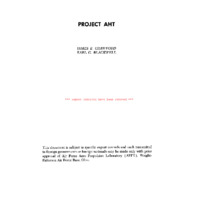-
Title
-
Project AHT
-
Date
-
1967
-
Index Abstract
-
Not Available
-
Photo Quality
-
Complete
-
Report Number
-
AFAPL TR 67-30
-
Creator
-
Crawford, James E.
-
Blackwell, Earl G.
-
Corporate Author
-
Space-General Corp El Monte CA
-
Laboratory
-
Air Force Aero Propulsion Laboratory
-
Extent
-
467
-
NTRL Accession Number
-
AD822598
-
Identifier
-
AD0822598
-
Access Rights
-
Export Controls
-
Distribution Classification
-
1
-
Contract
-
AF 33(615)-3469
-
DoD Project
-
None Given
-
DoD Task
-
None Given
-
DTIC Record Exists
-
No
-
Distribution Change Authority Correspondence
-
AFAPL LTR
-
Distribution Conflict
-
No
-
Date Modified
-
Scanned by request 1/4/2013 submitted by a Private Citizen (No Known Affiliation)
-
Abstract
-
Existing launch vehicles provide a capability orbit heavy payloads, but the payload compartment geometries are restircted in configuration and dimension. To fully exploit this payload capability, for manned or unmanned applications, dimensionally large structures that exceed the volume or geometic limitation of the payloads are required. Such structures can be obtained by deploying or erecting expandable materials in space, using systems that have been developed through Air Force contracts and private industry during the past few years. This contract centered on the application of these exandable materials in two particular types of space structures: a parabolic structure of high dimensional accuracy that could be used as an antenna, a solar collector or illuminator; and an airlock for use on manned space laboratories. The primary objectives of this study were to define in depth space experiments using the most practical expandable structure system studied, to finalize the design configuration of these experiments, and to evaluate potential subcontractors for the candidate expandable materials systems. The requirements for integrating the airlock and parabola into an effective experiment were identified for applications to sveral manned space laboratories including the Saturn SIVB SSESM. The experiments were found to be fully feasible and could be undertaken without the need for additional exploratory or basic development effort. The airlock and parabola experiments were designed to permit full astronaut mobility and participation in the experiment, without requiring unusual or excessive activity. The full range of operational requirements were examined and the experiments were defined to be compatible with these requirements. The design studies defined an airlock and a parabola for use in those experiments, that could be achieved using existing materials, processes and equipments. A 5.5-foot diameter spherical airlock experiment was designed using an elastic memory composite structural-material system, fully meeting the packaging, deployment, and operational requirements for demonstrating this expanding material system. A prototype airlock was constructed and tested under Space-General sponsorship which experimentally demonstrated the efficiency of the SGC material selection and design approach. A 10-foot diameter 45 degree rim angle parabola, constructed of precontoured modular honeycomb panels, was designed fir use as a space experiment to be manually assembled by the astronaut. The technological concepts employed in this experiment design reflect structural and task characteristics for similar structures up to 100 feet in diameter. The assembly concept and task requirements were demonstrated in neutral buoyancy tests by a pressure-suited test subject. The elastic memory system design was found to be most applicable to an expandable airlock experiment for the currently planned missions. The chemically rigidized methods require further exploratory development; however, these methods offer many potential advantages for other mission applications.
-
Report Availability
-
Full text available
-
Date Issued
-
1967-03
-
Publisher
-
Wright-Patterson Air Force Base, OH : Air Force Aero Propulsion Laboratory, Directorate of Laboratories, Air Force Systems Command
-
Provenance
-
Lockheed Martin Missiles & Fire Control
-
Type
-
report
-
Format
-
1 online resource
 AFAPLTR67-030.pdf
AFAPLTR67-030.pdf